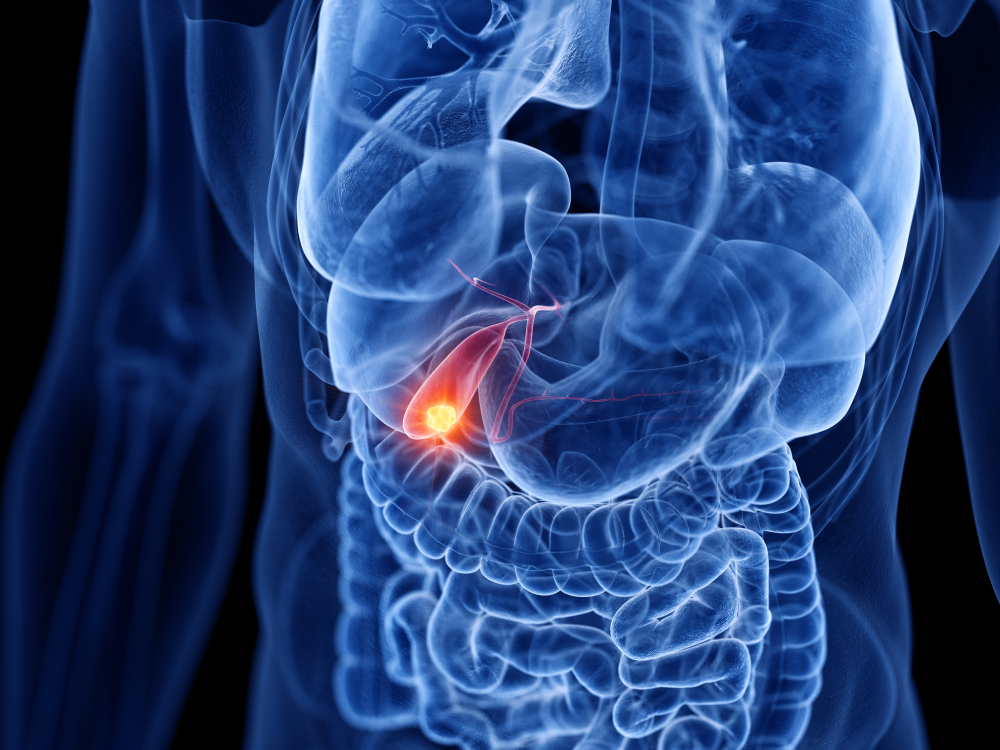Gallbladder Cancer

The gallbladder is a tiny pear-shaped organ located just underneath the liver on the right side of the body. The gallbladder is responsible for storing bile, a digestive fluid made by your liver. Gallbladder cancer is rare. If it is discovered at an early stage, the prognosis for treatment is good. However, most gallbladder cancers are discovered at a late stage, when the prognosis is often very poor and there aren't any specific signs or symptoms.
Symptoms:
The signs and symptoms of gallbladder cancer are-
- Pain in the abdomen, especially in the upper right side
- Abdominal bloating
- Fever or inflammation
- Nausea and vomiting
- Abdominal lumps
- Loss of weight
- Yellowing of the skin, whites of the eyes, and nail beds (jaundice)
Stages:
The biggest concern about cancer is metastasis (spread of cancer cells to distant site). To determine the extent of metastasis, certain numbers are assigned. This is known as "staging"; the greater the number, the more the cancer has progressed throughout your body.
The stages of gallbladder cancer are:
- Stage 0 (also known as "carcinoma in situ"): The cancer is confined to the gallbladder's mucosal (inner) layer.
- Stage 1: Cancer cells have reached the layer of the muscles
- Stage 2: Cancer has spread beyond the muscle layer to the connective tissue layer.
- Stage 3: Cancer has spread to the liver or organs near it, or to the outer layer (serosal), and possibly to the lymph nodes.
- Stage 4: Cancer has spread to more than three adjacent lymph nodes, nearby vessels, and/or organs that are located far from the gallbladder.
Diagnosis:
Gallbladder cancer is frequently discovered years after it has started since there are hardly any early warning signs or symptoms, and those that do exist resemble other disorders. If the doctor suspects gallbladder cancer, first a thorough examination is done and a complete medical history is documented. Other tests that will be required are-
Lab tests:
- Blood chemistry: - This test measures the levels of specific substances in your blood, including those that may indicate cancer.
- Liver function test (LFT): - LFT measures the levels of certain substances released by your liver, which may indicate the liver has been affected by cancer.
- Carcinoembryonic antigen (CEA) assay:- This measures the levels of CEA (a tumour marker released by both healthy and cancerous cells).
- CA 19-9 assay:- This test measures the levels of the tumour marker CA-19-9 in the blood. Higher levels of CA 19-9 may indicate gallbladder or pancreatic cancer.
Imaging tests: This is done to attain precise images of the gallbladder from different positions to find out the size, position, and damage done by the cancer. Some common imaging tests are:
- Abdominal ultrasound
- CT (or CAT) scan or PET CT scan
- Chest X-ray.
- MRI (magnetic resonance imaging)
- Endoscopic retrograde cholangiopancreatography (ERCP)
- Endoscopic ultrasound.
Other tests: These tests are done to confirm the presence of cancer or anomalous cells in the gallbladder.
- Biopsy
- Laparoscopy
Treatment:
The specialists involved in providing the complete treatment or cure are:
1. Surgeon/surgical oncologist: a cancer treatment specialist.
2. Medical oncologists: They help with chemotherapy and other medications.
4. Radiation oncologists: They help with radiation and help manage the spread of cancer.
5. Gastroenterologists: These specialise in the digestive system
To completely cure gallbladder cancer, it must be diagnosed at a very early stage before it has spread to other organs. The treatment commonly depends on the stage of cancer.
Cancer may be treated with:
- Surgery: The surgical removal of the gallbladder is called a cholecystectomy. Additionally, the surgeon may remove a portion of the liver close to the gallbladder as well as lymph nodes that are close to it.
- Radiation: Cancer cells are killed and stopped from multiplying while minimising damage to healthy cells. It uses a machine outside of the body to direct radiation to cancer. Radiation treatment may have side effects such as skin problems, nausea, vomiting, tiredness, liver damage, and/or diarrhoea.
- Chemotherapy: Chemotherapy uses drugs to kill cancer cells or stop them from multiplying. These may be injected or taken orally (by mouth). Chemo side effects include tiredness, easy bruising, easy bleeding, hair loss, loss of appetite, diarrhoea, nausea, and vomiting.
Some clinical trials are trying new types of treatment.
- Radiation sensitizers.
- Targeted therapy.
- Immunotherapy.
Conclusion:
Gallbladder cancer is a rare and deadly disease. If you notice the symptoms, make an appointment with your doctor as soon as possible. While some tumour show symptoms early on, gallbladder cancer may not be visible until it is advanced. It is critical to seek treatment as soon as possible in order to avoid fatalities or debilitating effects on both your physical and mental health.






